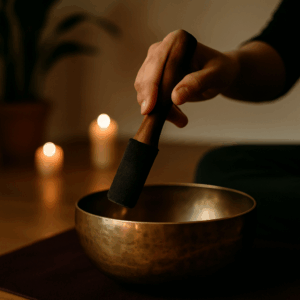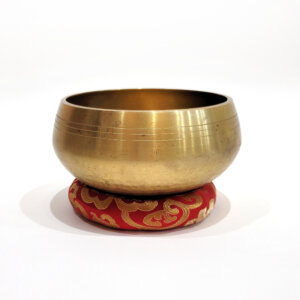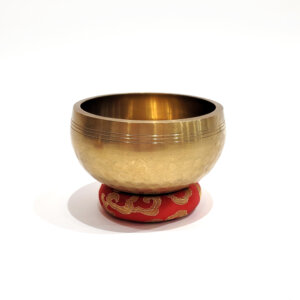How Meditation Instructors Can Use Singing Bowls to Deepen Student Experience
Table of Contents

In today’s wellness world, instructors are exploring new ways to enrich their classes. While breathwork and visualization remain core techniques, the introduction of singing bowls has brought new depth to guided experiences. These ancient instruments emit resonant tones that support relaxation, mindfulness, and energetic alignment. Instructors seeking to enhance their sessions are increasingly turning to singing bowls as powerful allies.
This guide explores how instructors can effectively use singing bowls to deepen the student experience. You’ll learn techniques, timing, bowl selection tips, and how to adapt sound use to suit different audiences.
The Power of Sound in Meditation Instruction
How Sound Shapes Inner Awareness in Meditation
Singing bowls emit frequencies that influence the brain’s activity. When used at the beginning of a session, the sound can quickly bring a sense of calm and receptivity. Students often describe the experience as dropping into stillness with ease.
Sound provides a steady anchor. It supports students who may find silent sitting difficult by offering a focal point that quiets mental activity. This sensory engagement encourages presence without cognitive effort.
Supporting Emotional Release Through Meditation
The vibrational quality of singing bowls can unlock suppressed emotions. During guided silence or breath-based exercises, playing a bowl helps create a container for safe emotional exploration. Instructors often use this during midpoint transitions or moments of energetic reset.
Techniques for Using Singing Bowls During Meditation Class

Opening Meditation Rituals
Start with a few gentle strikes to establish focus. Allow the sound to fully resonate before beginning guidance. This pause helps students transition from the external world into reflective space.
For group settings, this technique builds collective coherence. Everyone begins from the same sonic cue, establishing shared presence from the outset.
Midpoint Sound Reinforcement During Meditation
For longer sessions, sound can act as a gentle reminder. A single tone at ten-minute intervals helps maintain awareness. It replaces verbal prompts, preserving the meditative atmosphere.
Some instructors integrate bowl use into themed visualizations. Playing a tone associated with a specific chakra or emotion deepens the imagery and intention of the practice.
Closing the Meditation Session
End with a low, sustained tone or a slow sequence of taps. This signals the integration phase, encouraging students to internalize insights from their session. Sound helps bridge the inner state with returning to daily life.
Pairing this with a brief reflective prompt, such as setting a personal intention, helps reinforce post-session carryover.
Choosing the Right Singing Bowl for Meditation Practice Environments
Materials and Tonal Qualities
Tibetan bowls, made from metal alloys, produce warm, grounding overtones. They’re well-suited for sessions aimed at release and emotional grounding. Crystal bowls offer high, sustained pitches ideal for uplifting or expansive themes.
Many instructors keep both on hand to match session goals. A Tibetan bowl may begin the class, while a crystal bowl closes it.
Size and Frequency Considerations for Meditation
Larger bowls resonate with deeper frequencies. These are often used for first chakra work or calming anxious participants. Smaller bowls emit lighter tones that stimulate higher awareness.
Bowls tuned to musical notes allow instructors to structure sessions around specific energetic themes. A full set covers the seven chakras, making it easier to design sequential sound journeys.
Tools and Accessories
Suede mallets create smooth tones during rim-play, ideal for prolonged resonance. Wooden mallets deliver sharper impacts and are better for rhythmic marking.
Some facilitators incorporate stands, mats, or colored lighting to enhance sensory immersion.
Meditation Session Structuring and Sound Integration
Designing a Thematic Arc for Meditation Soundscapes
Use sound to define the session flow:
One tone to mark the beginning
A sustained note to transition inward
Targeted tones during guidance
Final harmonics to close
Vary sound intensity based on class type. Therapeutic sessions benefit from subtlety, while energy-based classes may use louder tones.
Adapting Sound for Different Meditation Group Types
Beginner students may need more verbal support alongside sound. In contrast, experienced participants often prefer extended periods of sound-only guidance.
Always check for auditory sensitivities. Offer alternatives like visual cues or silent segments when needed.
Creating Signature Sound Meditation Experiences
Instructors known for integrating sound often see higher retention. Singing bowls offer a distinguishing element that sets your offerings apart. You can also record sessions and offer them as digital downloads.
Consider building a sequence that becomes your signature format—perhaps starting every session with a specific tone and ending with a consistent sound ritual.
Why Sound Elevates Teaching Impact in Meditation
Deepening Student Connection
Sound reaches beyond words. It fosters nonverbal connection, making students feel seen and supported without verbal interaction. Singing bowls become a bridge between teacher and class.
Increasing Session Value
The inclusion of instruments enhances perceived value. Many students report feeling more complete and calm after sound-inclusive experiences, leading to increased word-of-mouth and loyalty.
Enhancing Instructor Presence
Using singing bowls requires focus and presence. Playing mindfully helps instructors stay grounded, which translates to more stable group energy.
Supporting Your Meditation Practice with Dionysus Artcrafts
At Dionysus Artcrafts, we offer singing bowls selected specifically for instructors. Whether you’re leading small classes or large retreats, our instruments are designed to support vibrational education and mindfulness facilitation.
We provide:
Chakra-aligned Tibetan and crystal bowl sets
High resonance bowls with acoustic testing
Accessories for studio or travel use
Consultation to help you build your personal toolkit
Bringing Sound and Stillness Together
Singing bowls offer more than auditory beauty—they shape the energy of your room, the emotions of your students, and the flow of your teachings.
Let sound support your next session. Build a practice that resonates—literally and energetically—with every person who enters your space.
Explore our curated collection of singing bowls for instructors and elevate your next class with sound that speaks to the soul.
Bring sound and serenity to your teaching — explore the artisan singing bowls at Dionysus Artcrafts!



